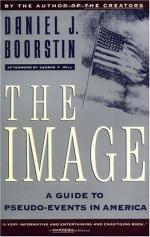
|
| Name: _________________________ | Period: ___________________ |
This test consists of 15 multiple choice questions and 5 short answer questions.
Multiple Choice Questions
1. What French sociologist, philosopher, cultural theorist, and photographer is frequently associated with postmodernism and post-structuralism?
(a) Jean Francois.
(b) Jean Baudrillard.
(c) Jean Michele Foucault.
(d) Michael Foucault.
2. Boorstin suggests that the graphic revolution and what else are mostly responsible for the abridgment and the mass production of art?
(a) Media.
(b) Capitalism.
(c) Commercialism.
(d) Democracy.
3. Boorstin writes that the amount of dissociation has become so absolute that what no longer feels real?
(a) The natural.
(b) The pseudo-event.
(c) The media.
(d) The pseudo-reality.
4. What refers to a single complete page, front and back, in a finished book?
(a) Single.
(b) Press page.
(c) Leaf.
(d) Double.
5. What company advertised the fact that the bottles were "steam-sterilized," neglecting to mention the fact that all the other beer companies used the same process?
(a) Budweiser Beer.
(b) Schlitz Beer.
(c) Miller Beer.
(d) Coors Beer.
6. What refers to something that is changed or modified to suit new conditions or needs?
(a) Conductation.
(b) Adaptation.
(c) Inductation.
(d) Redaptation.
7. Boorstin states, regarding foreign affairs, "I suspect we suffer abroad simply because people know America through" what?
(a) Nonreality.
(b) Pseudo-events.
(c) Television.
(d) Images.
8. Boorstin begins Chapter 5 - Section II discussing the differences between "ideal-thinking" and what?
(a) Concept thinking.
(b) Commercial thinking.
(c) Logic thinking.
(d) Image thinking.
9. What refers to the process or fact of personally observing, encountering, or undergoing something?
(a) Pseudo-experience.
(b) Experience.
(c) Action.
(d) Reality.
10. What word does Boorstin suggest we created out of the need to express the specialness of that which is real, in Chapter 6 - Section III?
(a) Fiction.
(b) Non-fiction.
(c) Arbitration.
(d) Capitalization.
11. Whose best-known films are The Ten Commandments, Cleopatra, and The Greatest Show on Earth?
(a) Adolf Zukor.
(b) Cecil B. DeMille.
(c) Mike Nichols.
(d) Carl Laemmle.
12. What refers to inexpensive fiction magazines published from 1896 through the 1950s?
(a) Pulp fiction.
(b) Dirt fiction.
(c) Dime store fiction.
(d) Romance fiction.
13. Daniel J. Boorstin was appointed twelfth Librarian of the United States Congress from 1975 until when?
(a) 1994.
(b) 1979.
(c) 1982.
(d) 1987.
14. What refers to something that exists independently of ideas concerning it?
(a) Experience.
(b) Action.
(c) Pseudo-event.
(d) Reality.
15. When does Boorstin say books began to be made cheaper, due to a variety of factors, in Chapter 4 - Section I?
(a) 1910s.
(b) 1840s.
(c) 1850s.
(d) 1890s.
Short Answer Questions
1. What production company, recognizing that actors and actresses would demand higher pay if they became well known, refused to give their names?
2. What is the fifth characteristic of the image, according to Boorstin?
3. In Chapter 6 - Section II, Boorstin warns that America has spent too much time attempting to "perfect our image rather than" what?
4. What does Boorstin write essentially means that people have accepted and bought into the image that we are trying to uphold?
5. What is the third characteristic of the image, according to Boorstin?
|
This section contains 463 words (approx. 2 pages at 300 words per page) |

|




